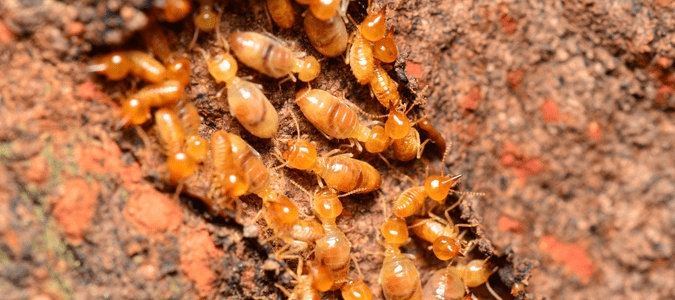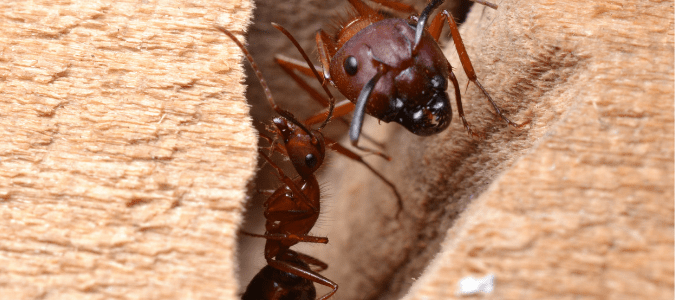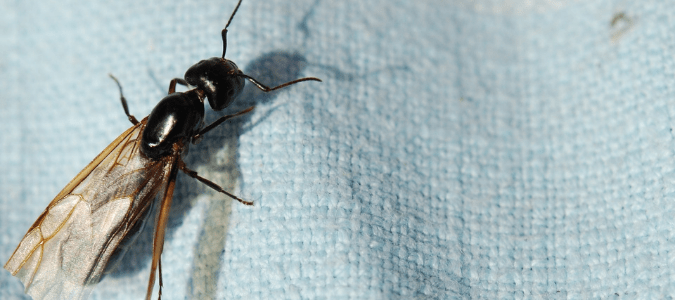Do you know the difference between termites and ants? These two pests are easy to confuse because of their many similarities. However, there are several physical differences between termites and ants that you can use to tell them apart.
Termites and ants also differ in their life cycle, habitat, reproductive process and caste system. Understanding their key differences will help you identify an infestation in your home.
Some termites and ants can fly, and they are the ones that leave their colonies to reproduce and start new colonies. Swarmer termites are often confused with flying ants.
Do Termites Look Like Ants?
It’s not easy to tell tiny insects apart from each other, and termites and ants are often mistaken. However, ignoring a termite infestation because you think they are ants will lead to more structural damage to your home.
Termite Appearance, Life Cycle, Habitat and More
Many homeowners find that it’s easier to spot the signs of a termite if they know what termites look like. There are several common termite species and most range in color from cream to dark brown. If you see black termites, they are the reproductive termites of the colony, also known as swarming termites. These termites are also the only ones with wings.
Termites, pictured above, vary in length depending on the species and their caste system. Subterranean termites range in length from three-eighths to half an inch long. Drywood termites range from a quarter of an inch to an inch long.
Termites have soft bodies with no exoskeletons. One thing that all termites have, regardless of their species, is two straight antennae.
Every termite species has a caste system, and each rank has a different role. Worker termites are the ones who search for food. They also build nests for the entire colony. Soldier termites protect the colony and alert the workers when a threat is nearby.
Swarmer termites are the only type that reproduces. When their colony reaches maturity, they fly out of the nest to mate and start new colonies. They only mate once and discard their wings after. One easy way to tell the difference between swarming termites and swarming ants is by looking at their wings. Termites’ wings are all the same length. On the other hand, ants have two long wings and two shorter wings.
Most mature termites only live for one to two years. However, queen termites may live for up to a decade. There are three termite life cycle stages: egg, nymph and adult. After hatching, nymphs take around one year to molt into adults.
Termites can live in various habitats, and their preference ranges based on their species. For example, subterranean termites require moisture and live most of their lives in mud tubes and underground nests that help keep their environment moist. On the other hand, drywood termites do not require moisture to survive.
All termites eat wood, which is why homes make excellent habitats for them. If you suspect that you have a termite infestation in your home, contact a pest control specialist.
Ant Appearance, Life Cycle, Habitat and More
When you look at a termite and an ant up close, they are easy to tell apart. Ants have more cinched-in waists than termites. They also have elbowed antennae as opposed to straight ones. Most ants are dark brown or black, but there are some yellow and red ants.
Ants, pictured above, range from five to 15 millimeters long, and they have exoskeletons. Some ant species are known for biting, but others can also sting. The ant life cycle has four stages: egg, larva, pupa and adult. Some species only take a few weeks to go through all of the stages and mature into adulthood, while others take months.
Like termites, ant colonies have a caste system. There are workers, queens and male ants. The worker ants are female ants that do not reproduce. They are in charge of building the nest, finding food and caring for the young. They do not have wings and only live for a few months.
Queen ants are reproductive females. They were fed more in the larvae stage than worker ants and grow much bigger. Like termites, they have wings that they use to find a mate before discarding them. Some queen ants lay millions of eggs and can live for up to a decade. Male ants only live for a few weeks, and their sole job is to reproduce with queen ants.
Ants build nests in the ground and construct tunnel systems to move through the earth. You can spot their nests by the small ant hills that form on the surface. If you have an ant problem on your property or in your home, contact a professional pest control service to get rid of them.
What Do Flying Termites Look Like?
Flying termites look similar to the other termites in their species; however, they have two pairs of long wings that double the size of their bodies. Their wings vary depending on species and may be cream, light brown or translucent. Their wing pairs are the same size and sit right on top of each other.
Flying subterranean termite bodies are around three-eighths of an inch long. Flying drywood termite bodies are usually a little over half of an inch long. They have two straight antennae, and their body is separated by their thorax and their abdomen.
As mentioned earlier, flying termites are the ones who reproduce and start new colonies. They are called swarmers because they leave their colonies at the same time and create swarms while they mate and find a new home.
After mating, they discard their wings. Homeowners often identify a termite infestation by spotting termite wings on their windowsills, floor or in their doorways.
Until they reach adulthood, flying termites go through the same life cycle as other types of termites, except for the fact that they develop wings and eyes. Before they are about to swarm, flying termites’ bodies start to harden. After mating, they may live for one or two more years.
Some homeowners will notice flying termites after rain. This is because rain can stimulate termite activity, which can help homeowners notice an active termite colony.
If you see flying termites in your home, contact a pest control specialist. Termites can cause severe structural damage that is costly to repair. A professional can implement an effective treatment plan.
What is a Carpenter Ant Swarm?
Carpenter ants also have swarmers in their colonies, and they are often mistaken for termites. However, their wings are much smaller than termite wings. Ant wings are two different lengths and barely extend past their bodies.
As you can see in the image above, flying carpenter ants have bent antennas. On the other hand, termites have straight ones. While both insects have segmented bodies, it’s easier to see the segments on an ant’s body because the waist is cinched in.
Like termites, carpenter ant swarmers also leave the nest to reproduce. They all leave at the same time, usually in the spring, and create swarms to protect themselves from predators.
Carpenter ants only reproduce once in their life, and the male ants die shortly after. After the queen establishes her new nest, she will break off her wings.
Female ants, also called queen ants, will find a new place to nest and lay their eggs. Carpenter ants like to bore into rotting wood and build their nests. They can also bore into healthy wood. If you see a swarm of flying ants in your home, it is a sign of an established colony nearby.
Flying Fire Ant Swarm
Fire ant swarmers are a common annoyance for many homeowners in the spring through early fall. These fire ant swarmers, which are larger and have wings, are typically more present after rainfall when humidity is high.
You can tell the difference between fire ant swarmers and termite swarmers by their appearance; fire ant swarmers have a narrower waist between their thorax and abdomen, their front wings are longer than their back wings and they have a bent segment in their antennae.
If you notice swarming fire ants indoors, this typically means that there is an outdoor nest close to the building foundation. Treating fire ants swarmers on your own can be difficult. It’s best to contact a pest control professional who can effectively treat these pests.
Reach Out to a Professional
Contact a pest control service if you see small flying insects in your home or on your property and you aren’t sure if they’re ants or termites. An expert will identify the pest and use professional-grade solutions to control the infestation.
Whether you have termites or ants in your home, it’s important to act quickly when you notice the signs of an infestation. Both types of insects have swarmers that fly away from their nests to mate and form new colonies. After mating, they may discard their wings around your home.
While termites are more known to cause structural damage to your home, carpenter ants can also cause damage by boring into your wood. It’s important to call a pest control professional if you suspect an infestation.
ABC Can Help With Pest Infestations of Any Kind
Finding termites in and around your property can be extremely concerning. These pests are destructive and their colonies can hold thousands of members. If you suspect termites on your property, contact ABC Home & Commercial Services. Our professionals will be able to locate the termite colony and then implement an effective termite control plan.





